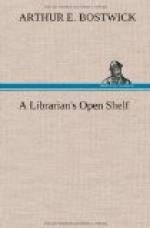Class Per cent.
Estimated per
Fiction
cent. of narrative
Juvenile 26
Adult 32 ........... 58
58
History ................. 6
6
Biography ............... 3
3
Travel .................. 3
3
Literature .............. 7
3
Periodicals ............. 4
2
Sciences ................ 9
3
Arts .................... 3
1
Philos. & Relig. ........ 2
1
Foreign ................. 5
4
—–
—
100
84
In other words, if my estimates are not too much out of the way—and I have tried to be conservative—only 16 per cent. of our whole circulation, and 38 per cent. of our non-fiction, is non-narrative, despite the fact that our total fiction percentage is low.
I attach little importance in this regard to any distinction between true and fictitious narrative, people who read novels do not enjoy them simply because the subject matter is untrue. They enjoy the books because they are interesting. In fact, in most good fiction, little beside the actual sequence of the events in the plot and the names of the characters is untrue. The delineation of character, the descriptions of places and events and the statements of fact are intended to be true, and the further they depart from truth the less enjoyable they are. Indeed, when one looks closely into the matter, the dividing line between what we call truth and fiction in narrative grows more and more hazy.
In pictorial art we do not attempt to make it at all. Our museums do not classify their pictures into true and imaginary. Our novels contain so much truth and our other narrative works so much fiction, that it is almost as difficult to draw the line in the literary as it is in the pictorial arts. And in any case objections to a work of fiction, as well as commendations, must be based on considerations apart from this classification.




